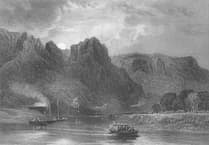I remember from my St Briavels days, half a century ago, the Polish Scouts House, hidden in the woods in the deepest Hudnalls in the remote wooded area between the village and the River Wye, writes Dave Kent.
Some St Briavels residents were unaware of this institution, hidden as it was in the depths of the woodlands, but I remember meeting one or two of the Polish Scouts workers who come up to the village from time to time to visit the Crown Inn, a popular village inn at the time, now sadly no longer in business.
They would walk up to the village through the sleepy roads and narrow lanes that meander across St Briavels Common and Hudnalls between the village and the Wye.
The Polish Scout Camp was first opened in the Hudnalls in 1952, but had to be closed for extensive renovations in 2013.
A replacement building, Wood House, was opened in September 2019 welcoming many guests, benefactors and donors to the St Briavels Stanica Harcerska (Scout camp) St Briavels – the Polish scout centre now known as Wye Valley Woodside Centre.
The original building, the White House, will soon also be open for young people of Polish heritage to enjoy the Wye Valley.
Hudnalls is not on the road to anywhere, a dead end off the bewildering network of narrow lanes between St Briavels and Brockweir.
You pass the Scouts camp, as you walk along the side of the Wye between the Brockweir and Bigsweir bridges, which was the route taken when my wife and I walked Offa’s Dyke from Beachley to Prestatyn many years ago.
The official path from Brockweir is up to St Briavels, a climb of 800 feet, but after the earlier climbs that day to Wintours Leap and the Devils Pulpit overlooking Tintern we decided to take a gentler route, along the River Wye between the two ancient weirs at Brockweir and Bigsweir, and, just by Hudnalls, passing another weir, the Coed Ithel weir, which was once part of the estate of Tintern Abbey.
It is a peaceful walk, overlooked by wooded hillsides on either side of the river, but in the 19th century and earlier it was a busy and important commercial area, with many local workers making a living from fishing and river transport.
There was no bridge at Brockweir before the 20th Century, but there were 17 pubs in the village to cater for the river workers.
The river traffic served both sides of the river Wye, eventually competing with the Wye Valley rail service. This river is still recalled in the name of the ancient pub in the Bristol harbour area, the Llandoger Trow, celebrating the flat bottomed cargo boats, known as trows.
These vessels brought merchandise and employment to the area on both sides of the river, and enabled Wye valley produce to be traded with the rest of the world.
This part of the Wye Valley is now a scenic place of wooded hillsides and a peaceful river, but in its time was an important industrial and commercial area.





Comments
This article has no comments yet. Be the first to leave a comment.